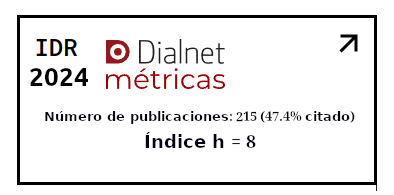Learning Styles Type Indicator: una adaptación para estudiantes medios y universitarios argentinos
Palabras clave:
Estilos de aprendizaje, personalidad, estudiantes, psicometría, evaluacónResumen
Se presenta un artículo instrumental que busca adaptar una herramienta para evaluar los estilos de aprendizaje vinculados a la personalidad, en estudiantes de nivel medio y universitario. La evaluación integral de los estilos de aprendizaje incluye tres grupos de estilos: centrados en la personalidad, en el procesamiento de la información y en el ambiente. En el ámbito local solo se dispone de instrumentos para evaluar los dos últimos tipos de estilos. El Learning Styles Type Indicator (LSTI) es una escala breve que mide estilos de aprendizaje vinculados a la personalidad de los estudiantes (Extroversión-Introversión, Sensación-Intuición, Pensamiento-Sentimiento, Juicio-Percepción). El estudio consistió en la adaptación lingüística, conceptual y psicométrica para su uso en estudiantes de nivel medio y universitario de Argentina. Para ello, se tradujo el instrumento del inglés al español y se realizó un análisis de validez de contenido. Luego, se analizó su estructura interna mediante un análisis factorial exploratorio que conservó ocho reactivos agrupados en dos factores (Extroversión-Introversión y Sensación-Intuición). El modelo se verificó a partir del cálculo de un análisis factorial confirmatorio, al igual que su equivalencia métrica según género y nivel educativo. Así, se obtuvo una versión breve para evaluar dos estilos de aprendizaje asociados a la personalidad de estudiantes de nivel medio y universitario en el medio local.
Descargas
Citas
Ali, M. M. (2016). Are we asking the same questions in different contexts: Translation techniques in cross-culture studies in science education? Journal of Turkish Science Education, 13(1), 31–44. https://doi.org/10.12973/tused.10155a
Alonso, C. M., Gallego, D. J., & Honey, P. (1994). Los estilos de aprendizaje: Procedimientos de diagnóstico y mejora. Mensajero.
Altamirano-Droguett, J. E., Araya-Crisóstomo, S. P., & Contreras, M. P. (2019). Estilos de aprendizaje y rendimiento académico de estudiantes de la carrera de obstetricia. Revista Ciencias de La Salud, 17(2), 276. https://doi.org/10.12804/revistas.urosario.edu.co/revsalud/a.7937
Anselmi, P., Colledani, D., & Robusto, E. (2019). A Comparison of Classical and Modern Measures of Internal Consistency. Frontiers in Psychology, 10. https://doi.org/10.3389/fpsyg.2019.02714
Ato, M., López-García, J. J., & Benavente, A. (2013). Un sistema de clasificación de los diseños de investigación en psicología. Anales de Psicología, 29(3). https://doi.org/10.6018/analesps.29.3.178511
Bedeian, A. G. (2014). More than meets the eye: A guide to interpreting the descriptive statistics and correlation matrices reported in management research. Academy of Management Learning & Education, 13(1), 121–135. https://doi.org/10.5465/amle.2013.0001
Bosman, A., & Schulze, S. (2018). Learning style preferences and Mathematics achievement of secondary school learners. South African Journal of Education, 38(1), 1–8. https://doi.org/10.15700/saje.v38n1a1440
Bunce, L., & Bennett, M. (2019). A degree of studying? Approaches to learning and academic performance among student ‘consumers.’ Active Learning in Higher Education, 146978741986020. https://doi.org/10.1177/1469787419860204
Chae, M.-O. (2016). Empathic ability and communication ability according to Myers-Briggs Type Indicator(MBTI) Personality Type in Nursing Students. Journal of the Korea Academia-Industrial Cooperation Society, 17(4), 303–311. https://doi.org/10.5762/KAIS.2016.17.4.303
Civelek, M. E. (2018). Essentials of structural equation modeling. In Zea Books. https://doi.org/10.13014/k2sj1hr5
Curry, L. (1983). An organization of learning styles theory and constructs. 67 Th Anual Meeting of the American Educational Research Association. https://files.eric.ed.gov/fulltext/ED235185.pdf
Davidov, E., Schmidt, P., Billiet, J., & Meuleman, B. (2018). Cross-cultural analysis. Methods and applications. Routledge.
Delić, H. (2020). The analysis of learning styles among high school students. Journal of Education and Humanities, 3(1). https://doi.org/10.14706/JEH2019222
DeVries, D., & Beck, T. (2020). Myers-Briggs Type Indicator Profile of Undergraduate Therapeutic Recreation Students. Therapeutic Recreation Journal, 54(3). https://doi.org/10.18666/TRJ-2020-V54-I3-9510
Dimitrov, D. M. (2010). Testing for factorial invariance in the context of construct validation. Measurement and Evaluation in Counseling and Development, 43(2), 121–149. https://doi.org/10.1177/0748175610373459
Doménech-Betoret, F., Abellán-Roselló, L., & Gómez-Artiga, A. (2017). Self-Efficacy, satisfaction, and academic achievement: The Mediator Role of Students’ Expectancy-Value Beliefs. Frontiers in Psychology, 8. https://doi.org/10.3389/fpsyg.2017.01193
Eddaif, B., Boriky, D., Mustapha, F., Sadik, M., Hanine, M. A., Kasour, R., Moustad, M., & Talbi, M. (2017). Transition from High-School to University: Obstacles and difficulties. IOSR Journal of Research & Method in Education (IOSRJRME), 07(02), 33–37. https://doi.org/10.9790/7388-0702013337
Felder, R., & Soloman, B. (1997). Index of learning styles. https://www.webtools.ncsu.edu/learningstyles/
Fleming, J. S., & Merino Soto, C. (2005). Medidas de simplicidad y de ajuste factorial: un enfoque para la evaluación de escalas construidas factorialmente. Revista de Psicología, 23(2), 250–266. https://doi.org/10.18800/psico.200502.002
Freiberg Hoffmann, A, & Fernández Liporace, M. (2021). Inventory of learning processes-versión breve: Adaptación y análisis psicométrico en estudiantes de nivel medio y universitario de Argentina. Revista Argentina de Ciencias Del Comportameinto.
Freiberg-Hoffmann, Agustín, Abal, F., & Fernández Liporace, M. (2020). Cuestionario Honey-Alonso de Estilos de Aprendizaje: Nuevas evidencias psicométricas en población argentina. Acta Colombiana de Psicología, 23(2), 328–348. https://doi.org/10.14718/ACP.2020.23.2.13
Freiberg Hoffmann, Agustín, & Fernández Liporace, M. (2013). Cuestionario Honey-Alonso de estilos de aprendizaje: Análisis de sus propiedades Psicométricas en Estudiantes Universitarios. Summa Psicológica, 10(1), 103–117. https://doi.org/10.18774/448x.2013.10.41
Freiberg Hoffmann, Agustín, & Fernández Liporace, M. (2020). Grasha–Riechmann student learning style scales: an Argentinian version. Journal of Applied Research in Higher Education, 13(1), 242–257. https://doi.org/10.1108/JARHE-12-2019-0325
García de Fanelli, A. M. (2014). Rendimiento académico y abandono universitario: Modelos, resultados y alcances de la producción académica en la Argentina. Revista Argentina de Educación Superior, 6(8), 9–38.
García de Fanelli, A. M. (2015). La cuestión de la graduación en las universidades nacionales de la Argentina: Indicadores y políticas públicas a comienzos del siglo XXI. Propuesta Educativa, 24(43), 17–31.
Hong, W., Bernacki, M. L., & Perera, H. N. (2020). A latent profile analysis of undergraduates’ achievement motivations and metacognitive behaviors, and their relations to achievement in science. Journal of Educational Psychology, 112(7), 1409–1430. https://doi.org/10.1037/edu0000445
Ishak, N. binti, & Awang, M. M. (2017). The relationship of student learning styles and achievement in history subject. The International Journal of Social Sciences and Humanities Invention. https://doi.org/10.18535/ijsshi/v4i3.04
Jung, C. G. (1921). Psychological types. Princeton University Press.
Katz, M. H. (2006). Multivariable analysis (2a ed.). Cambridge University Press.
Keefe, J. W. (1988). Profiling and utilizing learning styles. NASSP.
Kharb, P. (2013). The Learning styles and the preferred teaching–learning strategies of first year medical students. Journal of Clinical and Diagnostic Research. https://doi.org/10.7860/JCDR/2013/5809.3090
Kin, L. W., & Rameli, M. R. M. (2020). Myers-Briggs Type Indicator (Mbti) personality and career indecision among malaysian undergraduate students of different academic majors. Universal Journal of Educational Research, 8(5A), 40–45. https://doi.org/10.13189/ujer.2020.081906
Kolb, A. Y., & Kolb, D. A. (2009). The learning way. Simulation & Gaming, 40(3), 297–327. https://doi.org/10.1177/1046878108325713
Koohestani, H., & Baghcheghi, N. (2020). A comparison of learning styles of undergraduate health-care professional students at the beginning, middle, and end of the educational course over a 4-year study period (2015–2018). Journal of Education and Health Promotion, 9(1), 208. https://doi.org/10.4103/jehp.jehp_224_20
Li, C.-H. (2016). Confirmatory factor analysis with ordinal data: Comparing robust maximum likelihood and diagonally weighted least squares. Behavior Research Methods, 48(3), 936–949. https://doi.org/10.3758/s13428-015-0619-7
Lorenzo-Seva, U., & Ferrando, P. J. (2020). Manual of the Program FACTOR. http://psico.fcep.urv.es/utilitats/factor/Download.html
Merino-Soto, C., & Livia-Segovia, J. (2009). Confidence intervals for the content validity: A Visual Basic com-puter program for the Aiken’s V. Anales de Psicología, 25(1), 169–171.
Moreno, R., Martínez, R., & Muñiz, J. (2004). Directrices para la construcción de ítems de elección múltiple. Psicothema, 16(3), 490-497.
Myers, I. B. (1962). The Myers-Briggs Type Indicator Manual. Educational Testing Service.
Panayides, P. (2013). Coefficient Alpha: Interpret With Caution. Europe’s Journal of Psychology, 9(4), 687–696. https://doi.org/10.5964/ejop.v9i4.653
Pelley, J. (2015). The success types Learning Style Type Indicator. https://www.ttuhsc.edu/medicine/medical-education/success-types/lsti.aspx
Pérez V, M. V., Valenzuela Castellanos, M., Díaz M, A., González-Pienda, J. A., & Núñez, J. C. (2013). Dificultades de aprendizaje en estudiantes universitarios de primer año. Atenea (Concepción), 508, 135–150. https://doi.org/10.4067/S0718-04622013000200010
Randall, K., Isaacson, M., & Ciro, C. (2017). Validity and reliability of the Myers-Briggs Personality Type Indicator: A systematic review and meta-analysis. Journal of Best Practices in Health Professions Diversity, 10(1), 1–27.
Riechmann, S. W., & Grasha, A. F. (1974). A Rational Approach to Developing and Assessing the Construct Validity of a Student Learning Style Scales Instrument. The Journal of Psychology, 87(2), 213–223. https://doi.org/10.1080/00223980.1974.9915693
Schmeck, R. R., Ribich, F., & Ramanaiah, N. (1977). Development of a Self-Report Inventory for Assessing individual differences in learning processes. Applied Psychological Measurement, 1(3), 413–431. https://doi.org/10.1177/014662167700100310
Schumacker, & Lomax, R. (2016). A beginner´s guide to structural equation modeling. Routledge.
Scientific Software International. (2006). LISREL (8). http://www.ssicentral.com/lisrel/resources.html
Shi, R., & Yang, Y. (2009). Exploring the construct validity of the chinese version of the Myers-Briggs type indicator-G. Social Behavior and Personality: An International Journal, 37(5), 591–599. https://doi.org/10.2224/sbp.2009.37.5.591
Snape, D., Kirkham, J., Preston, J., Popay, J., Britten, N., Collins, M., Froggatt, K., Gibson, A., Lobban, F., Wyatt, K., & Jacoby, A. (2014). Exploring areas of consensus and conflict around values underpinning public involvement in health and social care research: a modified Delphi study. BMJ Open, 4(1), e004217. https://doi.org/10.1136/bmjopen-2013-004217
Steinmayr, R., Weidinger, A. F., Schwinger, M., & Spinath, B. (2019). The Importance of Students’ Motivation for their academic achievement – replicating and extending previous findings. Frontiers in Psychology, 10. https://doi.org/10.3389/fpsyg.2019.01730
Timmerman, M. E., & Lorenzo-Seva, U. (2011). Dimensionality assessment of ordered polytomous items with parallel analysis. Psychological Methods, 16(2), 209–220. https://doi.org/10.1037/a0023353
Travis, J., Kaszycki, A., Geden, M., & Bunde, J. (2020). Some stress is good stress: The challenge-hindrance framework, academic self-efficacy, and academic outcomes. Journal of Educational Psychology, 112(8), 1632–1643. https://doi.org/10.1037/edu0000478
Ventura-León, J. L., & Caycho-Rodríguez, T. (2017). El coeficiente Omega: un método alternativo para la estimación de la confiabilidad. Revista Latinoamericana de Ciencias Sociales, Niñez y Juventud, 15(1), 625–627.
Ventura, A. (2015). Estilos de aprendizaje y estilos de enseñanza en el ámbito de la educación superior [Universidad Nacional de Mar del Plata]. http://rpsico.mdp.edu.ar/bitstream/handle/123456789/246/TD05.pdf?sequence=3
Wolters, C. A., & Brady, A. C. (2020). College students’ time management: a self-regulated learning perspective. Educational Psychology Review. https://doi.org/10.1007/s10648-020-09519-z
Zheng, B., Chang, C., Lin, C.-H., & Zhang, Y. (2021). Self-efficacy, academic motivation, and Self-Regulation: How do they predict academic achievement for medical students? Medical Science Educator, 31(1), 125–130. https://doi.org/10.1007/s40670-020-01143-4
Zhou, M. (2011). Learning styles and teaching styles in college english teaching. International Education Studies, 4(1). https://doi.org/10.5539/ies.v4n1p73










